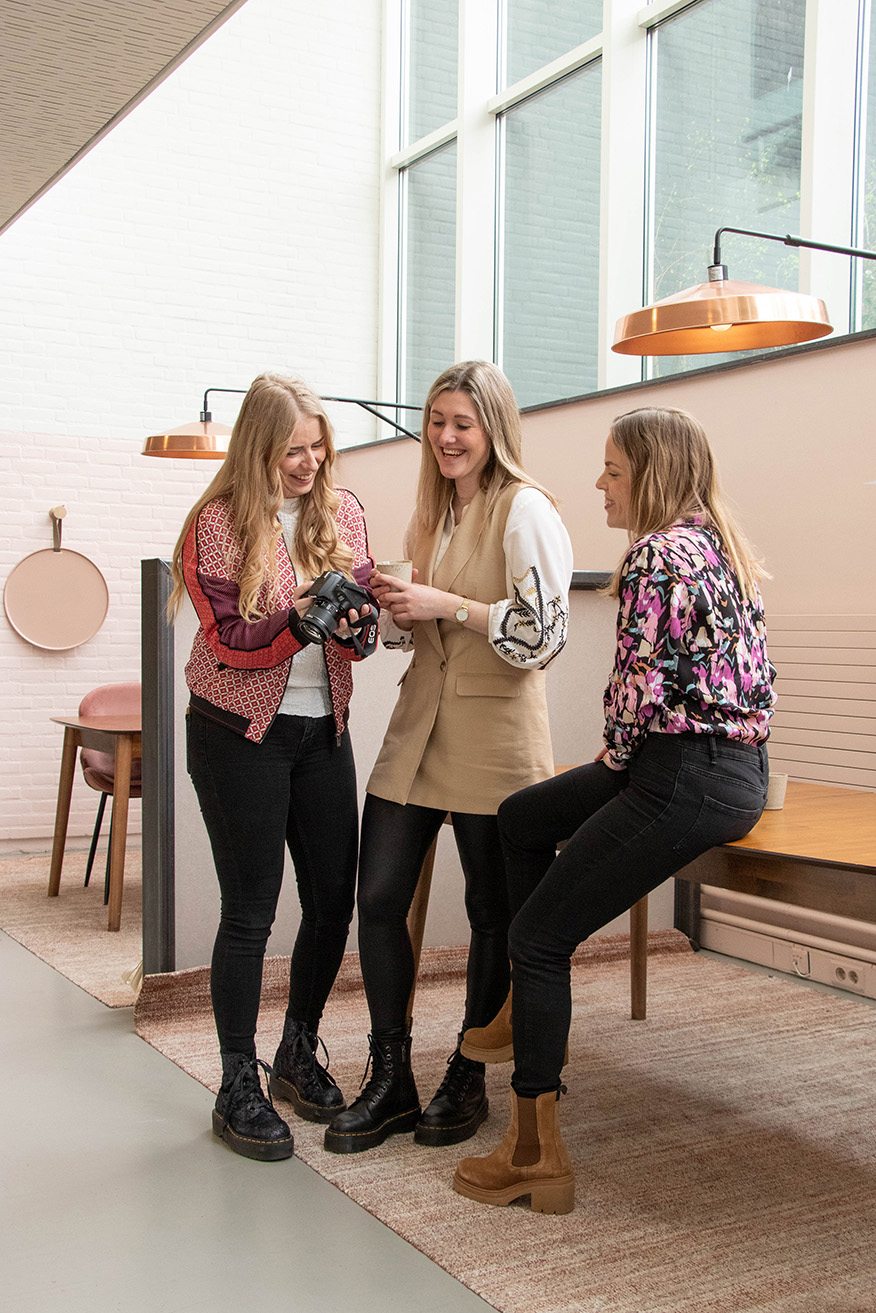Back in the days, we used to type on typewriters, until Word Perfect made its appearance. And remember when having a fax machine in your office was the meaning of modernity? Times have certainly changed a lot. The fax machine has long disappeared from the average office landscape. Typewriters were replaced by computers, which in turn are being replaced by laptops and tablets. Likewise, office furniture has changed considerably over time. In this blog, we will tell you all about office furniture trends from past to present.
A bit of history
The emergence of "the office" as we know it today has been a very unclear process. What we can say for sure, is that it all started with people doing paperwork. Think of Monks during the Middle Ages who spent entire days copying texts using graceful lettering. The modern-day office space developed further when accounting gained importance.
 Due to the invention of reinforced concrete and the use of steel in building constructions, the use of wood has decreased since the late 19th century.
Due to the invention of reinforced concrete and the use of steel in building constructions, the use of wood has decreased since the late 19th century.
The 19th-century office spaces first began to resemble the modern-day office spaces as we know them today. During this age of industrialization, office work began to play an increasingly important role in society. Since this time, office spaces steadily grew to become the workplaces we know today.
Large spaces and heavy desks during the 20th century
During the early 20th century, office spaces were mainly large open spaces filled with heavy wooden cylinder desks. Office furnishings were hardly ever thought about, as the layout of the office spaces resembled schools for the most part. Employees were mainly men in suits. Arriving at the office in a casual outfit was certainly not an option during this time. A growing number of women also started working at the office from the 20th century. They mainly fulfilled the roles of secretaries and assistants.
Working while standing at your desk is seen as the newest trend and one that is quickly gaining in popularity. However, this was already quite normalized back in the 20th century. For example, you could often find so-called typewriter stands in the office: a high table on which one had to type while standing up. Another interesting difference is that the CEO was often the only person within a firm that had his own private office space.
 A gray, sleek office interior at Van Diemenstraat 200.
A gray, sleek office interior at Van Diemenstraat 200. Gray and dull
In the 1950s and 1960s, the use of heavy wood diminished and was replaced by steel. The desks from this time are lighter, but also become a lot duller in terms of the color scheme. When looking back at this period now, many people would describe the style of office furnishings back then as drab and boring.
The looks of the office spaces were clearly not a priority at this point in time. Instead, the practical convenience of the office furniture was deemed most important. Think, for example, of large bulky filing cabinets and bright fluorescent lighting. Undoubtedly practical, but not really beneficial in terms of creating a pleasant environment in the office space.
In the 50s and 60s, pratical convenience came first.
During these years, the well-known American cubicles were invented. You may recognize these cubicles from any American film or series that takes place at the office. A cubicle is a small partitioned off-area that is suited for one person, most often only containing a desk, computer, and office chair. Ironically, these seemingly impersonal little cubicles were actually invented to meet the need of employees for personal space and privacy. However, they were often used to achieve the exact opposite, namely: housing many employees on very few square meters so as to increase productivity.
 A modern version of the American cubicles in the office building at Marten Meesweg 25G.
A modern version of the American cubicles in the office building at Marten Meesweg 25G.More attention to color in the office interior
During the 1970s, flower power and colorful furniture became the trend. Fortunately for all office workers, this invasion of color also broke through in business and office design. At last, the boring gray interiors were replaced with bright and vibrant office furniture in several colors.
The boring gray office spaces were replaced by colorful and vibrant interior during the 1970s.
The telephone line was also introduced during this time, resulting in office workers having a telephone on their desk in addition to a typewriter. Unfortunately, this colorful revival only lasted a decade. During the 1980s, many office spaces started using brown color schemes. However, the 1980s did bring us one of the most well-known inventions of that time: the fax machine.
Private workspaces
Up until the 1990s, office workers mainly worked in one large open office interior. Only the American cubicles deviated from this concept. However, during the 1990s, employees were increasingly assigned private workspaces. The large open-plan office spaces disappeared and were replaced by private workspaces that allowed employees more privacy, peace and space. In addition, a very important invention was introduced: the personal computer. Many workers got their own personal computer for the very first time. Office furniture also changed in color: from 80’s brown back to sleek gray.
In the '90s, large open-plan office spaces were replaced by private workspaces.
Back to open workspaces
We have entered the next century. The popularity of the private workspaces during the 1990s was short-lived. Many people realized that these private workspaces, while offering silence and personal space, reduced cooperation and friendly contact between colleagues. For this reason, open-plan office spaces made their return in the 21st century.
These open workspaces became a particular hit among small companies, now also known under the term 'startup'. Furthermore, the massive computer screens that many employees had on their desks, are steadily being replaced by lightweight laptops that can be taken anywhere
 Open-plan office space: a large open area with several workplaces
Open-plan office space: a large open area with several workplacesThe office of today
We have finally reached the modern-day office spaces we all know today. Even though we do recognize that open workspaces promote collaboration, we also found that they can cause inconvenience through ambient noise. To account for this, we created separate spaces for different activities, also known as Activity Based Working.
Office furniture has become more important. Various studies have shown the positive effects of office furnishings on issues such as productivity, creativity, and employee health. Sufficient daylight and a lot of greenery, for example, are shown to have a positive effect on productivity and are thus seen as important in today's office environment.
There have been many studies on office productivity, creativity and employee health in recent years.
In addition, it is good for your health to regularly alternate sedentary work with a brief period of standing up. Furthermore, a messy environment also appears to stimulate creativity. We would not recommend you to incorporate the latter throughout your entire office space, but it can be used to your advantage in a meeting room, for example. In the modern-day office, atmosphere and employee happiness are becoming increasingly important. After all, given that we are spending so much time in the office, we want to be as comfortable in the office as we would be at home.
 Prepare for the future with technological solutions in your office.
Prepare for the future with technological solutions in your office. A look at the office design of the future
We would like to take you for a ride to the office space of the future. Even though it is impossible to look into the future, we can already make some cautious predictions of what the office space of the future will look like. For example, we foresee that technological solutions will play an increasingly important role in every office design. Think of features like a digital reception, a smart lock on your door, or a booking display on which visitors can easily book a meeting.
Technological solutions will play an increasingly important role in furture office furnishings.
Instead of being seen as special, these appliances will have become the standard in the future. In addition, the catering industry will continue to play an important role. Company canteens will no longer be ordinary company canteens, but will steadily become real catering establishments where employees can eat a delicious and healthy lunch alongside a tasty juice or a fresh smoothie. Although much is still unclear, we know one thing for sure: the office furnishings are only getting better. Do you also want to take a look in the future? For more inspiration about the office of the future, please take a look at Officekit.
Go to Officekit!

 At Jansbuitensingel 7
At Jansbuitensingel 7



